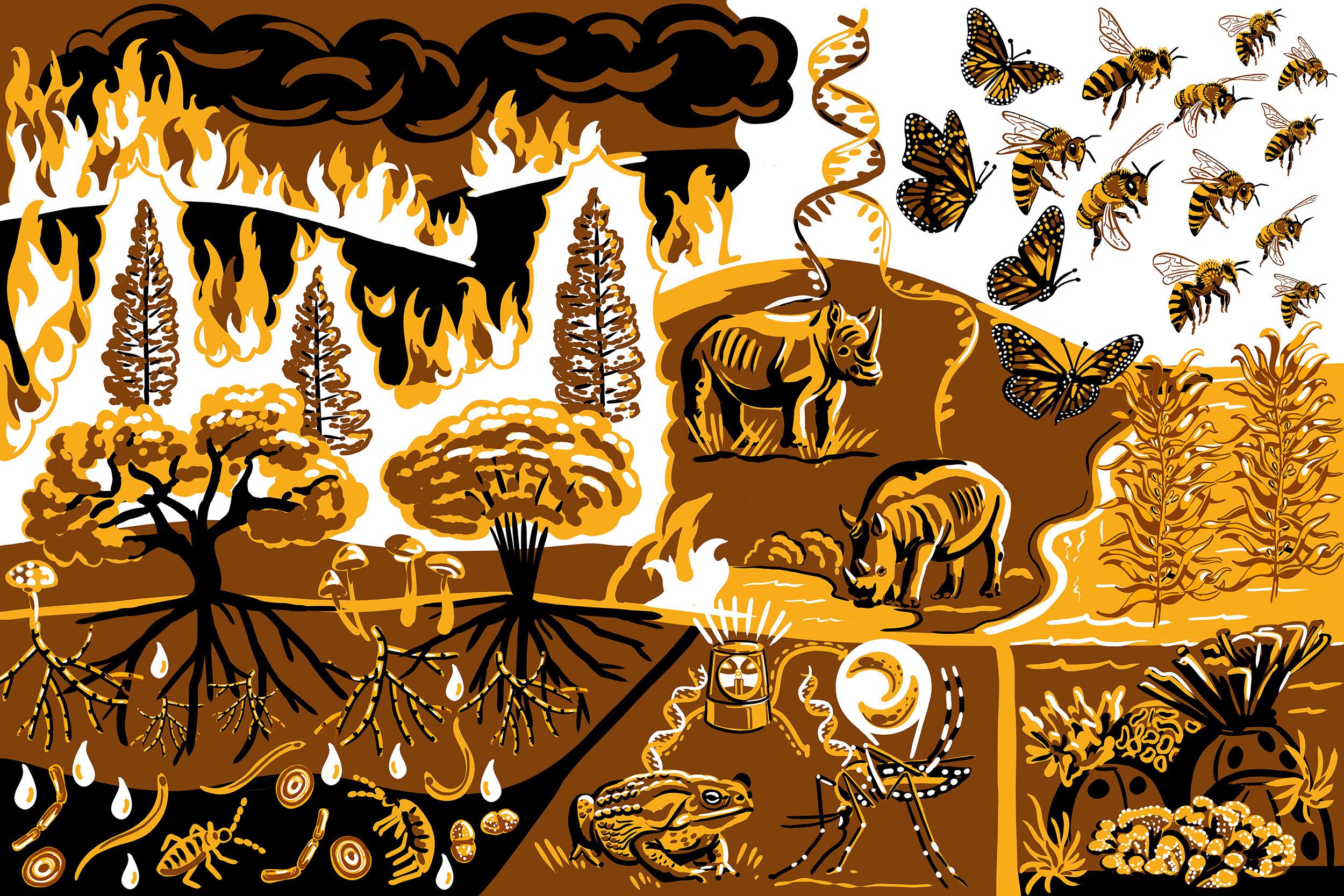Engineering Biology for Climate & Sustainability
Conservation of Ecosystems and Biodiversity
Conservation of Ecosystems and Biodiversity addresses opportunities for engineering biology to contribute to the monitoring of ecosystem members and their health, distribution, and diversity, and pinpoints the need for strong biocontainment strategies that are necessary for all engineering biology applications.
Introduction
Climate change is a threat to ecosystems and biodiversity world-wide. Biodiversity is a measure of variation at the genetic, species, and ecosystem level. Biodiversity is an important element of the vibrance and health of our planet and supports human existence by providing food, medicine, shelter, and protection from diseases. Biodiversity is not distributed uniformly on Earth, but rather concentrated in particular ecosystems and hotspots that are vulnerable to mass extinctions due to rapid environmental changes produced by climate change. For example, the Great Barrier Reef — a biodiversity hotspot with thousands of known species — is threatened by mass bleaching events due to rising ocean temperatures. The Conservation of Ecosystems and Biodiversity technical theme focuses on engineering biology approaches that could complement nature-based solutions to restore and protect biodiversity and ecosystems, including addressing the issue of biocontainment. The technical theme approaches supporting ecosystem health through the lens of engineering biology opportunities, however, like the rest of this roadmap, solutions must be considered in coordination with other fields of science and engineering, including the social sciences, as well as with local and indigenous communities who will experience the greatest impacts on their activities and livelihoods, and with the global community through appropriate policy and regulation to ensure risk reduction and limitation of harmful effects.

Engineering biology tools for ecosystem resilience and biodiversity conservation. Ecosystem damage and destruction is accelerating due to climate change and anthropogenic activity; however, there are many opportunities for engineering biology to support resilience and restoration of impacted environments and species. For example, engineering biology could help to restore forest soil microbiomes to aid recovery from forest fires, provide nutrient support and physical scaffolding to protect and support ocean corals damaged by heat and acidification, and with genetic and metabolic engineering, help to revive pollinator species. Engineering biology might also help to preserve genetic biodiversity in foundational, keystone, and threatened species, and could be used to monitor ecosystem health with sustainable, nature-friendly biosensors and reporters. Regardless of the potential application, robust biocontainment will be necessary for any engineering biology tool and technology intended for environmental use; biocontainment strategies should thoroughly be considered and implemented to prevent negative impacts. Importantly, advancements in genetic tools, consortia engineering, and data modeling need to be achieved in collaboration with ecologists and scientists and engineers from other fields, and local communities to understand system level impacts and priorities.
Approaches to preserving and restoring biodiversity should encompass tools and methods that support the resilience of both individual organisms or species and entire ecosystems that have been or could be adversely affected by climate change. In this roadmap we consider engineering biology-based approaches with a focus on three aspects of ecosystem resilience and health affected by climate change: supporting forest health, particularly where it has been impacted by drought and forest fire; resilience of marine ecosystems as they are being damaged by increased temperatures, acidification, and pollution; and the protection of ecosystems vulnerable to pathogens and invasive species that may be made worse by climate change.
Engineering biology also has the potential to help support the tracking and monitoring of existing and evolving biodiversity within ecosystems and reducing biodiversity loss by supporting keystone and foundational species. This roadmap describes technical opportunities in developing biosensors and reporting systems to detect changes in biodiversity and understand interactions within ecosystems to maintain their resilience. Through increased characterization of ecosystem components and biodiversity, engineering biology can enable genetic approaches toward protecting and enabling beneficial adaptation of species that are necessary for ecosystem health.
Finally, one of the most important factors in applying engineering biology, particularly on environmental scales, is preventing negative impacts of engineered organisms on biodiversity. Responsible and responsive biocontainment efforts are necessary to ensure that engineered organisms and systems are to the benefit of their environment and will not cause harm, whether through escape or biocontainment breach, or in persisting or acting beyond their intended target application. This roadmap identifies potential strategies for not only ensuring robust biocontainment, but also understanding the impact of engineering biology in the environment. While biocontainment is considered in this technical theme, good practices in biocontainment should inform and apply to all biotechnologies envisioned by this roadmap.
Environmental biotechnology in Engineering Biology
EBRC’s 2019 roadmap, Engineering Biology: A Research Roadmap for the Next-Generation Bioeconomy, includes technical approaches to achieving ecosystem resilience. These objectives and achievements include enabling ecosystems to adapt to climate change, including monitoring impacts through biosensors, increasing drought-tolerance, improved nutrient uptake, and soil health and preservation. Engineering Biology also addressed controlled deployment of engineered organisms into the environment to support biodiversity and ecosystem robustness.
view →
